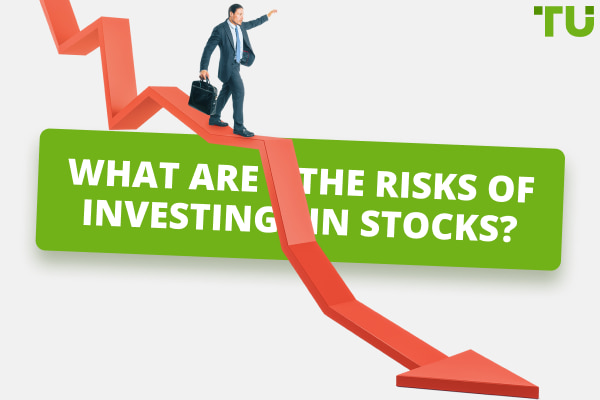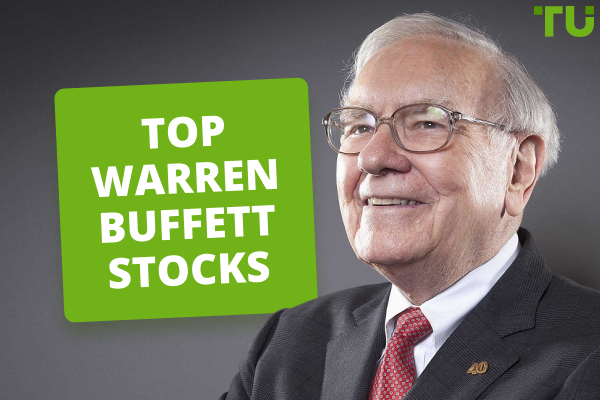How to Invest in Stocks for Beginners with Little Money? Best Ways to Begin
Most people have a perception that they need a huge capital to start the journey of investing in stocks. But, this perception is far from reality. Did you know the most professional investors started their investing careers with small capital? Did you hear about the online brokers that facilitate investing in stocks free of cost? Did you know that you can start investing in stocks with as little as $100?
You can find the best stocks for beginners with little money on platforms such as eToro, Webull, Interactive Brokers.
You don’t need a huge capital to start investing in stocks. You may become a successful investor over a period if you put effort to learn personalized investment strategies and develop appropriate investing behavior. We, at Traders Union, put together this guide to help beginners understand the process of investing in stocks with little money.
Is It Possible to Invest in Stocks With Little Money?
It is possible to invest in stocks with little money. You can open a brokerage account with one of the online brokers such as Webull, Robinhood, and Interactive Brokers free of cost. Most modern online brokers including, Webull and Robinhood offer a $0 minimum deposit. Huge capital isn’t a prerequisite to open a trading account and start the journey of investing in stocks.
The stocks of several fundamentally strong companies are available under $50 and $100. For example, the shares of Pfizer Inc. (NYSE: PFE), one of the leaders in the pharmaceutical industry, were available at $45 in January 2023. Most exchange-traded funds (ETFs) are also available in the range of $50 - $500. ETFs can be great investments as they are likely to be less volatile and reflect the returns of the major indices. For example, the iShares Core S&P 500 ETF that holds all the 505 stocks in the benchmark was available at $441 in January 2023. Vanguard Total International Stock ETF that holds several foreign stocks was available at less than $70.
Is it a Good Idea to Invest with Little Money?
The journey of every professional investor was started with a little capital. For instance, Warren Buffett, the stock market veteran, started his investing journey with just $120. Today, his portfolio is worth $100 billion. No investor will have a huge capital to invest during the initial days of investing career. Most investors start with small and build their positions over time systematically in regular intervals to create wealth.
During the initial days of investing journey, beginners may not have sufficient knowledge of operational aspects of stock markets. They may be incapable of comprehending the factors that could influence individual stocks. Investing huge capital into stock markets is risky for beginners who have not yet developed appropriate investing behavior and personalized investing strategies. So, it is always good to test the waters with small capital before committing big.
Investing in the stock market is one of the affordable ways to build wealth for retail investors who may not have large capital at their disposal. Investors may need to have huge capital to purchase other income-generating assets like real estate. For example, the average price for a square foot in New Yock City is $799 in January 2023. The median price for an apartment in Manhattan is $916,000.
Therefore, it is always good to start the investing journey with little money. Make systematic investments in fundamentally strong stocks to see the magic that the compound interest can create in the long run. If you are wondering how to trade stocks with $100, read the Traders Union article.
How to Invest in Stocks with Little Money - Beginner’s Guide
Most beginners become curious about the stock market by reading the stories of successful investors, but they don’t have an idea of the process involved in starting the investing journey.
Here is the step-by-step process on how to invest in stocks with little money:
Determine your Long-term Goals
A long-term goal is an objective with a timeframe of higher than one year. In investing, the long-term goals have a timeframe of anywhere between 3 and 10 years. The stock market investing journey goes out of the track if the investor does not have long-term goals.
We suggest investors adopt goal-based investing; a few examples of long-term investment goals are:
-
To create a corpus of $1 million by the time I attain the age of 60 for the retirement
-
To create a capital of $40,000 to purchase a new car by December 2025
-
To create a capital of $200K for the higher education of my child by December 2035
We suggest investors develop the long-term goals that they want to achieve by investing money systematically in individual stocks, mutual funds, real estate, ETFs, and other assets.
Learn how Compound Interest Works
“Compound interest is the 8th wonder of the world.” – Albert Einstein
One who does not understand how the compound interest works may not become a long-term investor. Compound interest occurs when the interest earned is added to the principal amount and then applies the interest rate to the new capital. The compound interest can be calculated daily, weekly, bi-weekly, monthly, quarterly, half-yearly, or annually.
The formula for the compound interest is:
A = P(1+r/n)nt
A - is the total amount you earn through compound interest
P - is the principal
r - is the annual interest rate
n - is the number of times the compounding is done in a year
t - is the total number of years
Analyze the Stock Market under $ 200
There are over 4000 listed companies in the United States. Since beginners have relatively lesser capital to invest, it is good for them to choose companies trading below $200; this enables them to purchase over 5 shares of a company with a capital of $1000.
The success of stock market investing depends on the ability of an investor to choose a company that could generate handsome returns in the future. If you choose a company with weak fundamentals, poor earning potential, high debt, and insufficient liquidity position, you may lose money in the stock market.
As Warren Buffett said, choose companies with economic moats; an economic moat is a competitive advantage that puts the organization ahead of its competitors. A robust distribution network, high-technological capabilities, patents, and brand identity are commonly known economic moats.
Know about Fractional Stocks
Wondering how to invest in large companies like Amazon (NASDAQ: AMZN) or Google (NASDAQ: GOOGL) that trade at a stock price higher than $2000?
Put your doubts aside as you can invest in these types of companies through fractional stocks. A fractional stock is a partial share of a company’s stock. Today, investors don’t need to wait for stock splits that reduce share price by up to half. They can purchase a fractional share to become the shareholders of the company.
Fund your Account
We suggest beginners choose a low-cost online broker that allows purchasing and selling shares and ETFs commission-free. Brokers like Webull, Robinhood, and Interactive Brokers are suitable for beginners. Upon opening a brokerage account, fund it with a capital of $100 or $200 to start the investing journey.
Buy your First Shares
Upon funding the account, the next step is to create a watchlist of fundamentally strong companies. A beginner may like to create a watchlist of 100 companies that he can monitor on regular basis. Choose the right company from the watchlist at the right time and purchase the shares of it.
Gradually Increase your Positions and Reinvest Profits
Investing is a long-term journey. We suggest investors follow a systematic approach to purchase shares. Stocks can be highly volatile in the short term. The share price may go down because of the unfavorable market conditions and sentiments. Add more shares to increase your position in a particular stock when its share price goes below the fair market value. Investors should also consider reinvesting dividends and profits to unleash the true potential of compound interest.
Stock Investing Rules from Billionaires
Professional investors like Warren Buffett, Peter Lynch, Ray Dalio, and Charlie Munger gave several public statements, quotes, rules, and principles that pave a way for a successful investing career. We have gathered a few rules from the books and speeches of these successful investors.
Rule 1: Invest for Longterm and Focus on Long-term Goals
Do not invest in a company if you cannot stay invested in it for at least 10 years. Focus on your long-term goals. Stocks give guaranteed returns in the long term. Longer timeframes nullify the volatility risk that commonly occurs due to changes in the macro-environment.
Rule 2: Buy stocks of companies whose business you understand well
Before purchasing the shares of an organization, make sure that you have sound knowledge of its operations, products, distribution network, competitors, market potential, and capital expenditure initiatives. This helps you to build a conviction on the stock you are going to purchase. People who work in the pharmaceutical industry may understand the pharma and biotech businesses well; they may not know information technology and hospitality companies. If you understand the pharmaceutical business, try to create a watchlist of pharma stocks and invest in them at the right time.
If you purchase a stock of a company whose business you don’t understand, you may undergo anxiety when its stock goes down due to an unknown macroeconomic factor. People who understand the business well may ignore the external noise and stick to the company as long as the fundamentals are intact.
Rule 3: Consider Diversifying your Stock Portfolio
Diversification protects your portfolio during a market crash. A diversified portfolio generates a handsome return on investment irrespective of the market conditions. You can diversify the portfolio by using the assets such as individual stocks, ETFs, mutual funds, bonds, certificates of deposits, gold, real estate, retirement accounts, and treasury bills.
Here is an example of the allocation within a diversified portfolio:
-
1
35% to stocks and ETFs
-
2
20% to real estate and REITs
-
3
12.5% fixed-income assets
-
4
10% to gold
-
5
10% to treasury bills
-
6
5% to the retirement account
-
7
8.5% to the cash or liquid funds.
If you want to play a pure equity investment game, you may look at diversifying the portfolio with 10 to 12 fundamentally strong companies along with two ETFs. Investors should remember that the over-diversification (more than 15 stocks in a portfolio) may not fetch the desired results.
Rule 4: Invest in an index through ETF
Warren Buffett always advises beginners to invest in index funds or ETFs. An ETF gives an instant benefit of diversification to the investor. Since ETFs comprise the stocks of major indices on NYSE and NASDAQ, investors would get a chance to hold several medium-to large-cap companies at one go. The returns of ETFs reflect the index returns. The ten-year annualized return of the S&P 500 Index between 2011 and 2020 was 13.9%. If you had invested in iShares Core S&P 500 ETF in 2011, you would have earned a minimum of 13.9% annualized return on investment for the last 10 years. If you don’t know the basics of equity investing, the best alternative is to stay invested in ETFs.
Rule 5: Analyze companies carefully before buying
Investors need to carry out a thorough fundamental analysis of the company before making a purchase decision.
Here is the list of 10 factors that an investor should evaluate before buying a stock
Check the growth potential of the industry and assess the ability of the organization to successfully tap this potential
Price-to-earnings ratio and a debt-to-equity ratio
Cash reserves of the company
Dividend-paying history
Quality of management team
Product lines and distribution networks
Corporate government principles of the organization (Stay away from the company that has poor corporate governance policies)
Liquidity and solvency situation of the company
Operational margin and free cashflows
Return on Capital Employed (ROCE) and Return on Equity (ROE)
Is it Possible to Invest in Stocks with no Money?
Yes, it is possible to invest in stocks without any money. The well-known brokers like Webull and Robinhood offer free promotional stocks when a user opens a brokerage account with their trading platforms.
Webull offers a free stock worth $3 to $300 as soon as a user opens a brokerage account on its trading platform. Users become eligible for second free stock worth $7 to $2000 upon depositing a minimum amount of $5. Robinhood gives a free stock worth $3 to $225 to the users as soon as they link the bank account to the trading account.
Interactive Brokers give referral bouns to both the referrers and referred clients. Every referrer at Interactive Brokers receives $200 when the referred client maintains a balance of at least $10,000 for one year. The referred clients receive $1 worth of IBKR welcome shares for every $100 they add to the account. The referred clients can earn up to $1000 worth of IBKR welcome shares.
Best Brokers to Invest With Little Money
We considered the factors such as minimum deposit, fractional trading, promo trades, and stock fees while analyzing and choose the best brokers. After a thoughtful analysis, we have chosen the three best brokers that facilitate trading with little or no money.
| Broker | Minimum Deposit | Fractional Shares (YES/NO) | Stocks Fees | Bonuses | |
|---|---|---|---|---|---|
$10 |
Yes |
$0 per trade |
None |
||
$0 |
Yes |
$0 per trade |
2 Free Stocks |
||
$0 |
Yes |
$0 per trade |
Referral Bonus |
How much can I earn by investing in stocks?
The average annualized return since the inception of the stock market in 1926 through 2018 was around 11%. The average annualized return of the S&P 500 index between 1957 and 2018 was around 8%. These statistics showcase that an investor can earn anywhere between 8% and 11% a year by investing in stocks.
However, the returns from the stock market are not guaranteed every year. Since stocks are highly volatile in the short term, we may see a few years every decade reporting a negative rate of return. For instance, the S&P 500 index has reported negative returns in 2000, 2001, 2002, 2008, and 2018 in the last 2 decades.
There were several years the S&P 500 Index reported a double-digit ROI between 2000 and 2020. A few notable years with higher than average ROI were 2003 with 28.68%, 2009 with 26.4%, 2013 with 32.3%, 2017 with 21.83%, and 2019 with 31.49%. If you're wondering how to buy an S&P 500 index fund, read the Traders Union article.
If you want to enjoy good returns from the stock market, you should stay invested in both lows and highs.
Can I lose money investing in stocks?
Yes, you may lose money if you consider investing in stocks as gambling. Investing is not gambling. Gambling is where you depend on your luck to earn returns. Investing is where you use various investment strategies including, portfolio management, diversification, fundamental analysis, and technical analysis to make an investment decision and build a portfolio.
Most novice investors lose money in stocks because they cannot control their emotions like greed and fear.
-
They invest in a company recommended by their friends and relatives out of greed without putting any effort into analyzing products, growth prospects, liquidity, debt, and solvency of the company
-
They sell the stock out of fear when its price goes down due to the negative market sentiment and end up reporting losses
Investors may use strategies such as portfolio management and diversification to minimize stock market losses. Portfolio management is the process of building a portfolio based on the risk appetite or risk tolerance levels of the investor and overseeing it to achieve the long-term financial objectives. Diversification ensures that the investor does not put all his money into a single investment. Diversification limits the loss percentage by allocating funds to different financial instruments and stocks of different industries.
If you want to know what the 5% rule is in portfolio management, read the Traders Union article.
Expert Opinion
Large minimum investments are not needed today thanks to innovative online brokerages that have eliminated trading fees and account minimums. This lowers the entry barrier significantly compared to previous years. For beginners just getting their feet wet, having no upfront costs makes it very easy to open an account and buy their first shares.
But too many novice investors can get caught up in short-term price fluctuations, when the real wealth-building power of equities emerges over periods of 5+ years as compound returns take effect. Investing is a marathon, not a sprint. Developing investing discipline demands aligning purchases with strategies tied to multi-year objectives. Having concrete financial objectives like saving for a home, retirement, or child's education can help avoid emotional reactions and keep your focus on the long run.
ETFs that track the total market are a smart core holding for hands-off exposure. However, I also consider analyzing individual company fundamentals as an important skill to develop over time. Choosing prudently after researching financial statements, industry trends, competitive advantages, and management quality can help you identify quality companies even within a smaller budget. Taking the time to learn serves you better than jumping in blindly.
FAQs
How long to invest a small sum of money in stocks?
Choosing a trading system is your right. You can invest money with a horizon of several years, reinvesting profits each month to protect against downturns. You can also practice active trading, where risks are higher, but so is the potential profit.
Can you be a millionaire from stocks?
It solely depends on you, on your strategy, experience, knowledge, patience, the amount at work, and emotional stability. Not everyone can become a millionaire, but it's worth striving for!
What stocks to invest $100 in to quickly double the deposit?
It depends on the market situation. Different stocks \“shot up" in various periods. In 2021, GameStop's shares could multiply in value within a few days. In 2023, Nvidia's shares more than doubled in a few months, aided by the boom in artificial intelligence technologies. In some years, U.S. stock indices showed annual returns of over 50%. Remember, the higher the return, the higher the risk.
How much money do you need to start on the stock market?
The minimum deposit amount according to the broker's conditions is usually sufficient to open trades on some stocks within risk management rules.
Team that worked on the article
Andrey Mastykin is an experienced author, editor, and content strategist who has been with Traders Union since 2020. As an editor, he is meticulous about fact-checking and ensuring the accuracy of all information published on the Traders Union platform. Andrey focuses on educating readers about the potential rewards and risks involved in trading financial markets.
He firmly believes that passive investing is a more suitable strategy for most individuals. Andrey's conservative approach and focus on risk management resonate with many readers, making him a trusted source of financial information.
Dr. BJ Johnson is a PhD in English Language and an editor with over 15 years of experience. He earned his degree in English Language in the U.S and the UK. In 2020, Dr. Johnson joined the Traders Union team. Since then, he has created over 100 exclusive articles and edited over 300 articles of other authors.
The topics he covers include trading signals, cryptocurrencies, Forex brokers, stock brokers, expert advisors, binary options. He has also worked on the ratings of brokers and many other materials.
Dr. BJ Johnson’s motto: It always seems impossible until it’s done. You can do it.
Mirjan Hipolito is a journalist and news editor at Traders Union. She is an expert crypto writer with five years of experience in the financial markets. Her specialties are daily market news, price predictions, and Initial Coin Offerings (ICO). Mirjan is a cryptocurrency and stock trader. This deep understanding of the finance sector allows her to create informative and engaging content that helps readers easily navigate the complexities of the crypto world.










